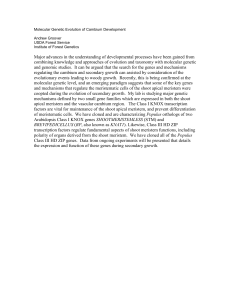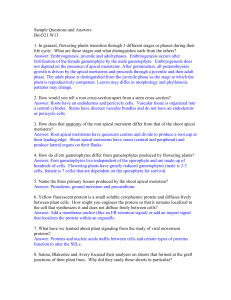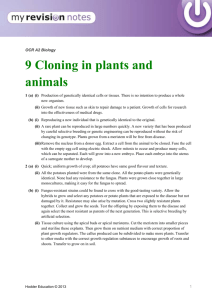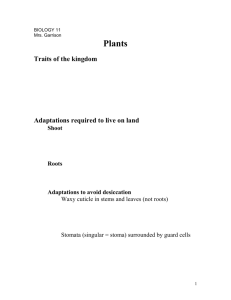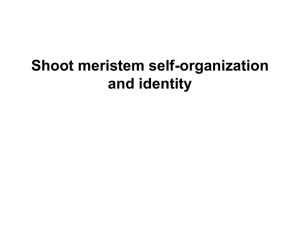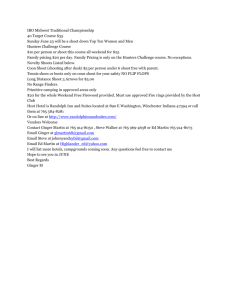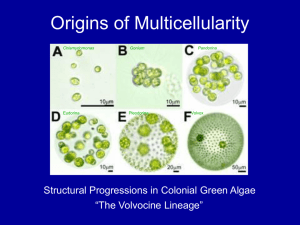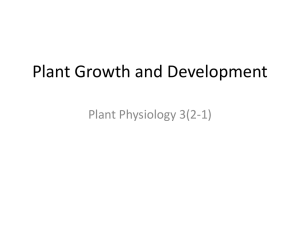Effect of cytokinins on shoot apical meristem in Nicotiana tabacum
advertisement
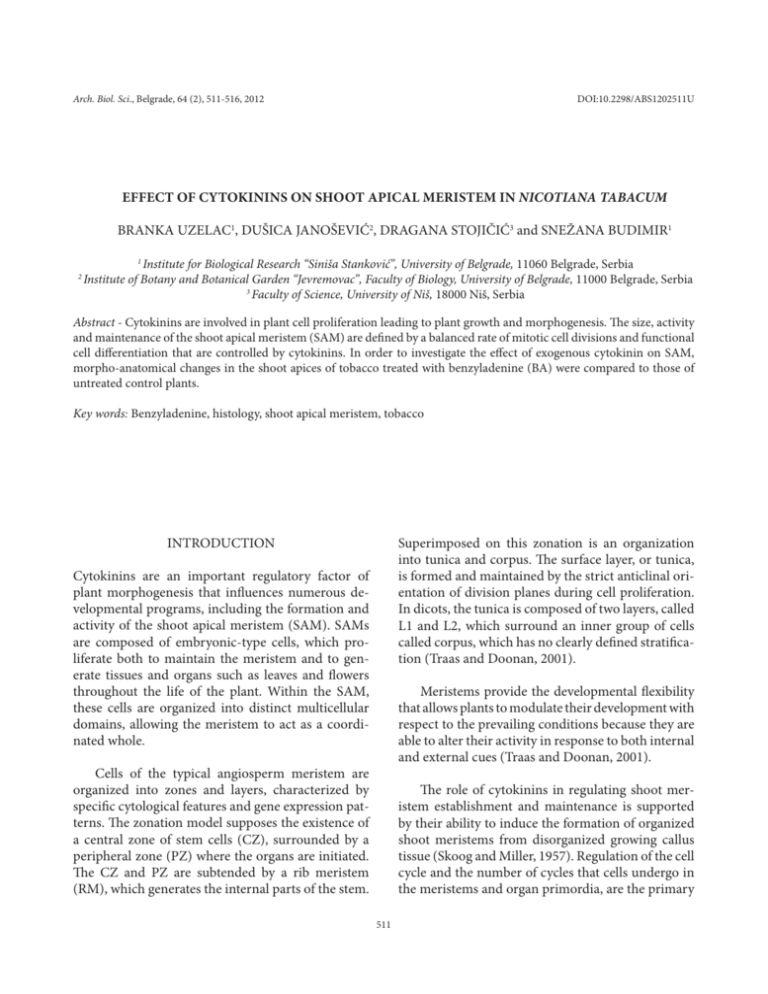
Arch. Biol. Sci., Belgrade, 64 (2), 511-516, 2012 DOI:10.2298/ABS1202511U EFFECT OF CYTOKININS ON SHOOT APICAL MERISTEM IN NICOTIANA TABACUM BRANKA UZELAC1, DUŠICA JANOŠEVIĆ2, DRAGANA STOJIČIĆ3 and SNEŽANA BUDIMIR1 2 1 Institute for Biological Research “Siniša Stanković”, University of Belgrade, 11060 Belgrade, Serbia Institute of Botany and Botanical Garden “Jevremovac”, Faculty of Biology, University of Belgrade, 11000 Belgrade, Serbia 3 Faculty of Science, University of Niš, 18000 Niš, Serbia Abstract - Cytokinins are involved in plant cell proliferation leading to plant growth and morphogenesis. The size, activity and maintenance of the shoot apical meristem (SAM) are defined by a balanced rate of mitotic cell divisions and functional cell differentiation that are controlled by cytokinins. In order to investigate the effect of exogenous cytokinin on SAM, morpho-anatomical changes in the shoot apices of tobacco treated with benzyladenine (BA) were compared to those of untreated control plants. Key words: Benzyladenine, histology, shoot apical meristem, tobacco INTRODUCTION Superimposed on this zonation is an organization into tunica and corpus. The surface layer, or tunica, is formed and maintained by the strict anticlinal orientation of division planes during cell proliferation. In dicots, the tunica is composed of two layers, called L1 and L2, which surround an inner group of cells called corpus, which has no clearly defined stratification (Traas and Doonan, 2001). Cytokinins are an important regulatory factor of plant morphogenesis that influences numerous developmental programs, including the formation and activity of the shoot apical meristem (SAM). SAMs are composed of embryonic-type cells, which proliferate both to maintain the meristem and to generate tissues and organs such as leaves and flowers throughout the life of the plant. Within the SAM, these cells are organized into distinct multicellular domains, allowing the meristem to act as a coordinated whole. Meristems provide the developmental flexibility that allows plants to modulate their development with respect to the prevailing conditions because they are able to alter their activity in response to both internal and external cues (Traas and Doonan, 2001). Cells of the typical angiosperm meristem are organized into zones and layers, characterized by specific cytological features and gene expression patterns. The zonation model supposes the existence of a central zone of stem cells (CZ), surrounded by a peripheral zone (PZ) where the organs are initiated. The CZ and PZ are subtended by a rib meristem (RM), which generates the internal parts of the stem. The role of cytokinins in regulating shoot meristem establishment and maintenance is supported by their ability to induce the formation of organized shoot meristems from disorganized growing callus tissue (Skoog and Miller, 1957). Regulation of the cell cycle and the number of cycles that cells undergo in the meristems and organ primordia, are the primary 511 512 BRANKA UZELAC ET AL. regulatory targets of cytokinins. Both locally synthesized and imported cytokinins not only control the cell proliferation rate (i.e. stimulate division activity in the SAM), but are also involved in regulating the transition from undifferentiated stem cells to differentiated primordia. This dual function of cytokinins in the control of SAM proliferation is achieved via the KNOX family homeobox genes (Chuck et al., 1996; Rupp et al., 1999), suggesting a model in which cytokinins and KNOX genes positively regulate each other to maintain the indeterminate state of the SAM. In the present study of cytokinin action in plant morphogenesis, the effect of exogenously applied benzyladenine on tobacco shoot apical meristem structure and cytophysiological zonation was histologically analyzed. MATERIALS AND METHODS Plant material and culture conditions Seeds of Nicotiana tabacum cv. Wisconsin 38 were kindly provided by the Botanical Garden of Nijmegen. The tobacco seedlings were germinated and grown for 6 weeks on half-strength MS (Murashige and Skoog, 1962) medium, supplemented with 1% (w/v) sucrose and solidified with 0.6% (w/v) agar. The pH of the medium was adjusted to 5.8 prior to autoclaving at 114°C for 25 min. The shoot apices with 1-2 leaves were then transferred to MS solid medium supplemented with 3% sucrose containing benzyladenine (BA) at 1, 3, 10, 30 and 100 μM, and cultured for an additional 3 weeks prior to examination. The same medium, but without BA, was used as the control. All cultures were maintained at 25 ± 2°C under a 16-h photoperiod. A photosynthetic photon flux density of 45 μmol m-2 s-1 was provided by white fluorescent tubes (Tesla, Pančevo, Serbia, 65 W, 4500 K). Histological analysis Twenty explants, each cultured on the control and BA-containing medium, were sampled. For light microscopy, the apical segments of the main axes devoid of expanded leaves were used. Samples were fixed in FAA (formalin/acetic acid/ethanol 10:5:85), dehydrated in a graded ethanol series and embedded in paraffin at 58˚C. Sections 5 µm thick were stained with hematoxylin and photographed using a Leitz DMRB photomicroscope (Leica Germany). Statistical analysis Five replicates, each consisting of two explants, were used per treatment, and the experiment was repeated twice. Of a total 20 samples for each treatment, 10 were used for histological analysis. The dimensions of SAMs in the median longitudinal sections were measured using UTHSCSH Image Tool program version 2.0 (University of Texas Health Science Center, San Antonio, Texas, USA). The data were subjected to one-way analysis of variance and significant differences between means from each treatment were determined using Fisher’s Least Significant Difference (LSD) test at the 95.0% confidence level. RESULTS Effect of cytokinins on shoot morphology Morphological changes induced by increased cytokinin concentration included reduced apical dominance, fasciation and abnormal adventitious shoot morphology. Axillary bud meristems were present in both control and BA-treated shoot tips. However, in the control explants, the primary shoot elongated and the leaves grew vigorously, while none of the axillary shoots developed (Fig. 1a). Benzyladenine in higher concentrations inhibited the growth of the main axis, simultaneously accelerating whole plant senescence (Fig. 1b-d). Numerous adventitious shoots were induced from the callus tissue formed at the basis of the BAtreated shoot cuttings (Fig. 1b-d). Callus growth as a function of treatment was not recorded, but visual observation indicated that more calli were produced at intermediate BA concentrations (3-30 μM). In explants cultured on 1 and 3 μM BA, the adventi- Cytokinin effect on tobacco SAM 513 Fig. 1. Morphology of Nicotiana tabacum shoot apices cultured with various levels of benzyladenine (BA) for 3 weeks. (a) Control plants with elongated stems and well-developed roots. (b) In explants cultured on 3 μM BA, numerous adventitious shoots emerged from the callus tissue formed in the basis of the main axis. Adventitious shoots were tiny leafy structures, with ovate leaves. (c) Bushy appearance of explants cultured at 10 μM BA, with well-developed axillary shoots and supernumerary adventitious shoots with shortened internodes. Note their intensely green leaves are frequently fasciated, with swollen midrib and petiole. (d) At 100 μM BA leaves of the primary explant are noticeably more yellowish, with the swollen main axis and the callus tissue formed in its basis. Note the very short adventitious shoots that are often displaying a cowl-shaped apical leaf (arrowhead). tious shoots were tiny leafy structures, the majority of which were simple with radial symmetry, and the leaves were ovate with an entire leaf margin (Fig. 1b). The numerous adventitious shoots that developed on higher BA concentrations (10-100 μM) were short with shortened internodes (Fig. 1c, d). Differentiated leaves were small and orbicular with thick, flattened leaf blades. Ectopic meristems frequently emerged along the midribs and at the periphery of the leaves that were often hyperhydrated and swollen (Fig. 1c). At BA concentrations ranging from 10 to 100 μM, short, broad and frequently bifurcated cowl-shaped leaves were observed (Fig. 1d). Histology The structure of shoot apices was examined under a light microscope after three weeks of cultivation on BA-supplemented media and compared to that of the control. 514 BRANKA UZELAC ET AL. played a normal organization and a regular arrangement into layers (L1, L2 and L3), exhibiting the usual planes of cell division (Fig. 2a). Fig. 2. Histology of Nicotiana tabacum vegetative shoot apical meristem (SAM) cultured with various levels of benzyladenine (BA) for 3 weeks. (a) Median longitudinal section of control SAM displaying regular organization into tunica and corpus; Bar = 50 μm. (b) Median longitudinal section of SAM in explant treated with 3 μM BA; Bar = 100 μm. (c) Median longitudinal section of SAM in explant treated with 10 μM BA; Bar = 100 μm. (d) Median longitudinal section of SAM in explant treated with 100 μM BA, displaying layers of flat cells as a result of coordinated periclinal divisions in the corpus (arrowhead); Bar =100 μm. In the longitudinal sections taken through the meristems of the control explants after three weeks of culture, two first leaf primordia were observed on the flanks of the shoot apical meristem (Fig. 2a). The meristems of the control plants consisted of a shallow dome of densely stained meristematic cells with large nuclei and lacking large vacuole. The meristem measured around 200 μm across the base, and had between 5 and 7 layers of avacuolate cells at its highest point (Table 1, Fig. 2a). The control plants dis- In the BA-treated explants, the shoot apical meristem was a rather shallow dome with a typical organization into tunica and corpus. However, compared to control SAM, it had an increased diameter and its surface was flatter and enlarged (Table 1, Figs. 2b-d). The meristems of explants cultured on 3-30 μM BA were significantly broader across the base, measuring maximum diameter (about 150% of the control) at 10 μM BA. With a further increase of of BA concentration, its effect on meristem diameter gradually decreased (Table 1). Compared to the control meristems, the regular arrangement of densely stained meristematic cells into distinct layers appeared to be somewhat less organized at BA concentrations of 10 µM and higher. Enlarged peripheral zones contained a few more vacuolated cells at the meristem flanks, in both L2 and L3, especially at 10 and 30 µM BA (Fig. 2c). At 100 µM BA, not so many vacuolated cells are present in the meristem, while the corpus was somewhat modified, having four to five layers of flat cells resulting apparently from coordinated periclinal divisions so that the corpus occasionally displayed stratified appearance (Fig. 2d). The number of cells in the uppermost L1 tunica layer was determined in all examined sections (Table 1). A significant increase in cell number in the L1 layer of the SAM was observed in explants cultured on media containing BA at 3, 10 and 30 μM after 3 weeks, reaching a maximum at 10 μM BA where an increase of nearly 50% of the control was recorded (Table 1, Fig. 2c). However, regardless of the cytokinin treatment, a similar SAM structure and cytophysiological zonation were observed for both control and BA-treated plants. DISCUSSION In the control plants, neither axillary nor adventitious buds developed, whereas the BA-treated explants had Cytokinin effect on tobacco SAM 515 Table 1. Effect of BA concentration on diameter and number of cells in L1 layer in shoot apical meristem of tobacco Diameter Cell number in L1 BA (μM) (μm) % of control 0 202.24 ± 10.50a 100 26.6 ± 1.9a 100 1 222.55 ± 12.49 110 ab 31.4 ± 1.3 118 3 252.69 ± 1.85bc 125 32.8 ± 0.7b 123 10 310.85 ± 14.85 d 154 39.2 ± 2.2 c 147 30 295.99 ± 28.22cd 146 33.4 ± 3.1b 125 100 230.31 ± 13.87 114 27.8 ± 1.3 104 ab ab % of control ab The values are means ± standard error, n=10. Means within a column followed by different letters are significantly different from each other at 5% level by Fisher’s least significant difference (LSD) test. 1) 2) a bushy appearance, confirming the ability of BA to overcome the apical dominance of shoots. An oversupply of cytokinin can account for stunting and/or fasciation of shoots, albinism and hyperhydricity, altered metabolism and anatomical and ultrastructural abnormalities. Ramage and Williams (2004) observed that elevated exogenous cytokinin levels lead to the initiation of abnormal shoots and that these cytokinin-induced abnormalities in shoot morphology are associated with an increase in the expression of a knotted1-type homeobox gene (TobH1) within the meristematic tissue. Herath et al. (2005) showed that in BA-treated plants of Hibiscus cannabinus, the primary shoot apical meristem of the BA-treated shoot tip was reprogrammed to induce several meristematic loci, which was never observed in the primary shoot apical meristems of tobacco shoot tips, regardless of the concentration of the BA used. A significant increase in SAM diameter was observed in the tobacco explants cultured on medium containing 3-30 μM BA. Further increase in BA concentration no longer had a stimulatory effect on cell division in the SAMs. As Huyluoglu et al. (2008) have shown for barley root tips, BA at 1 and 10 μM increased the mitotic indices, whereas 100 μM BA was shown to decrease division frequency compared to lower BA concentrations, exerting an inhibitory effect. The BA-treated SAMs of tobacco became enlarged due to the enlargement of both the peripheral and central zones. The pattern of increase in cell number closely followed the pattern of diameter changes for each BA concentration tested, suggesting that the increase in SAM diameter was most likely due to an increase in the number of its constituent cells. Unlike the quantitative parameters, the typical regular structure and organization of the SAM were not altered. Cytokinin is implicated in positively regulating meristem size and rapid leaf initiation. Transgenic tobacco plants expressing high levels of two cytokinin oxidase genes from Arabidopsis (CKX1 and CKX2), hence exhibiting reduced levels of endogenous cytokinin, developed stunted shoots with smaller apical meristems (Werner et al., 2001). In addition, Werner et al. (2003) showed that the overexpression of the CKX1 gene in transgenic Arabidopsis plants significantly reduced the endogenous cytokinin content and resulted in a strong reduction of the diameter and height of the meristem, which was attributable mainly to fewer meristematic cells, but also to the significantly decreased size of meristematic cells. The reduced size of the SAM, together with the retarded leaf formation and reduced cell production in the leaves, provides evidence that cytokinins are required as a positive regulator of cell division activity in the shoot. Interestingly, the diameter of the shoot apical meristem in cytokinin- 516 BRANKA UZELAC ET AL. overproducing ipt transgenics of Arabidopsis thaliana, displaying higher steady state mRNA levels of the SAM-specifying homeobox genes KNAT1 and STM, was not significantly different from that of the wild type (Rupp et al., 1999). Another link between cytokinins and meristem size comes from a mutant in Arabidopsis AMP1 gene. Nogué et al. (2000) have shown that the amp1 mutant has a meristem that is both larger and taller than the wild type, with an increased number of cells in the L1 layer compared to the wild type, and that this is associated with a higher endogenous cytokinin level in the meristem of the amp1 mutant. This is in accordance with the findings of our experiment, where the observed changes in tobacco SAM dimensions upon exogenous addition of cytokinin confirm the ability of cytokinin to increase mitotic activity in the SAM. Acknowledgment - This research was supported by the Ministry of Education and Science of Serbia, Grant N° 173015. REFERENCES Chuck, G., Lincoln, C. and S. Hake (1996). KNAT1 induces lobed leaves with ectopic meristems when overexpressed in Arabidopsis. Plant Cell 8, 1277-1289. Herath S.P., Suzuki, T. and K. Hattori (2005). Light and scanning electron microscopic analysis of benzyl adenine induced multiple shoot regeneration in kenaf (Hibiscus cannabinus L.). Breeding Science 55, 75-80. Huyluoglu, Z., Unal, M. and N. Palavan-Unsal (2008). Cytological evidences of the role of Meta-topolin and Benzyladenin in barley root tips. Adv. Mol. Biol. 1, 31-37. Murashige, T. and F. Skoog (1962). A revised medium for rapid growth and bioassays with tobacco tissue cultures. Physiol. Plant. 15, 473-497. Nogué, F., Grandjean, O., Craig, S., Dennis, E. and A. Chaudhury (2000). Higher levels of cell proliferation rate and cyclin CycD3 expression in the Arabidopsis amp1 mutant. Plant Growth Regul. 32, 275-283. Ramage, C.M. and R.R. Williams (2004). Cytokinin-induced abnormal shoot organogenesis is associated with elevated Knotted1-type homeobox gene expression in tobacco. Plant Cell Rep. 22, 919-924. Rupp, H.M., Frank, M., Werner, T., Strnad, M. and T. Schmülling (1999). Increased steady state mRNA levels of the STM and KNAT1 homeobox genes in cytokinin overproducing Arabidopsis thaliana indicate a role for cytokinins in the shoot apical meristem. Plant J. 18, 557-563. Skoog, F. and C.O. Miller (1957). Chemical regulation of growth and organ formation in plant tissues cultured in vitro. Symp. Soc. Exp. Biol. 11, 118-131. Traas, J. and J.H. Doonan (2001). Cellular basis of shoot apical meristem development. Int. Rev. Cytol. 208, 161-205. Werner, T., Motyka, V., Strnad, M. and T. Schmülling (2001). Regulation of plant growth by cytokinin. Proc. Natl. Acad. Sci. USA 98, 10487–10492. Werner, T., Motyka, V., Laucou, V., Smets, R., Van Onckelen, H. and T. Schmülling (2003). Cytokinin-Deficient Transgenic Arabidopsis Plants Show Multiple Developmental Alterations Indicating Opposite Functions of Cytokinins in the Regulation of Shoot and Root Meristem Activity. Plant Cell 15, 2532-2550.
